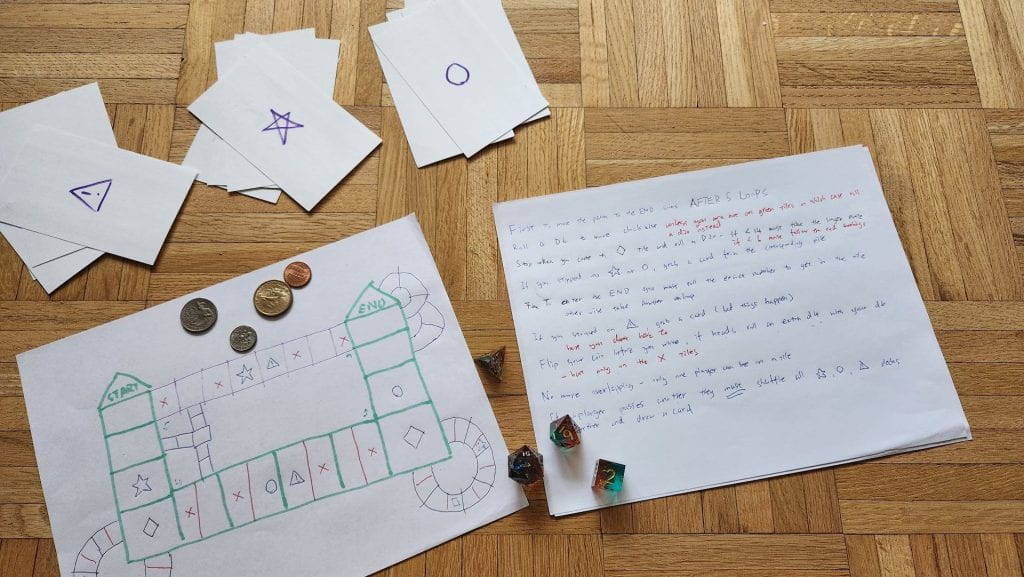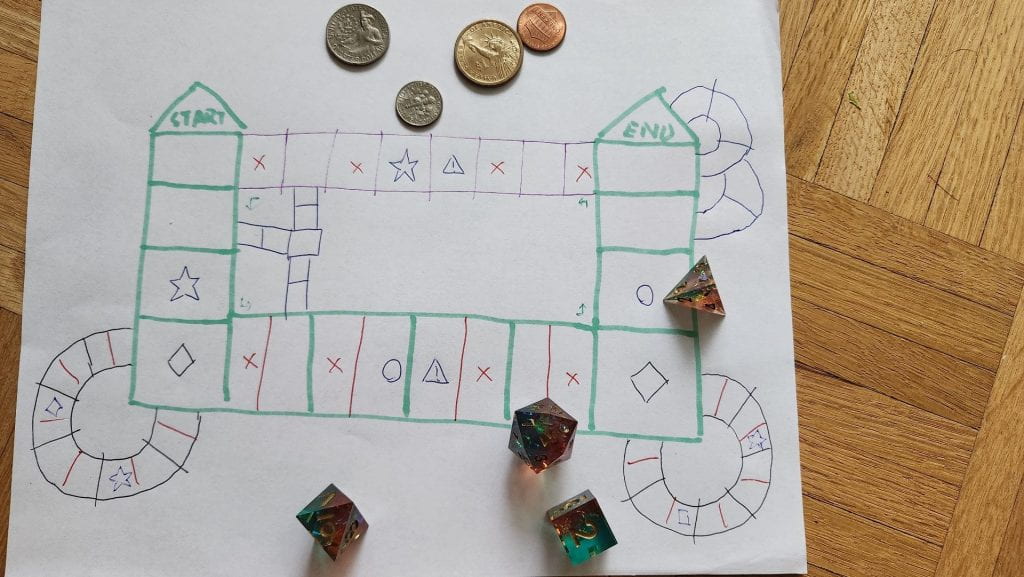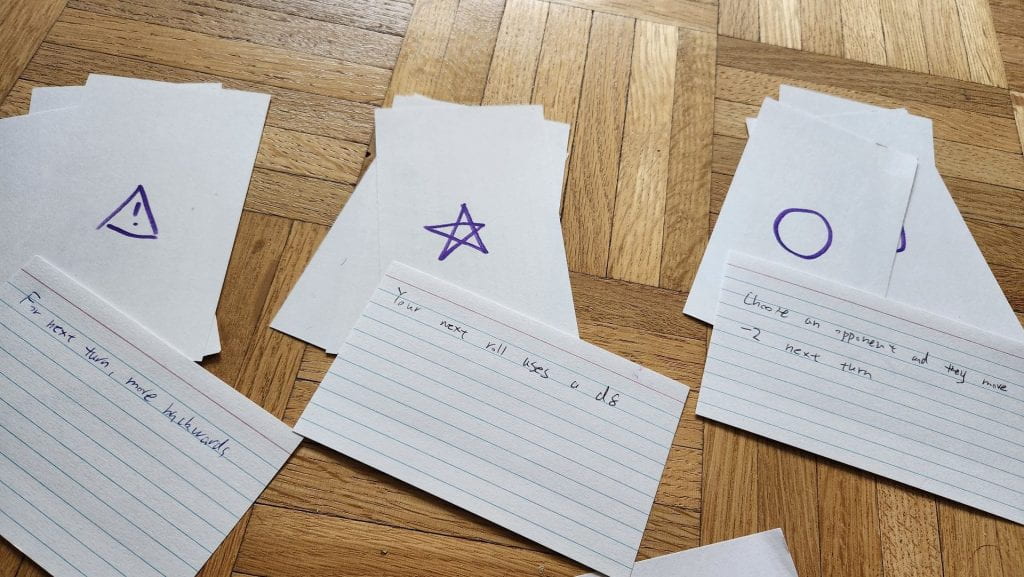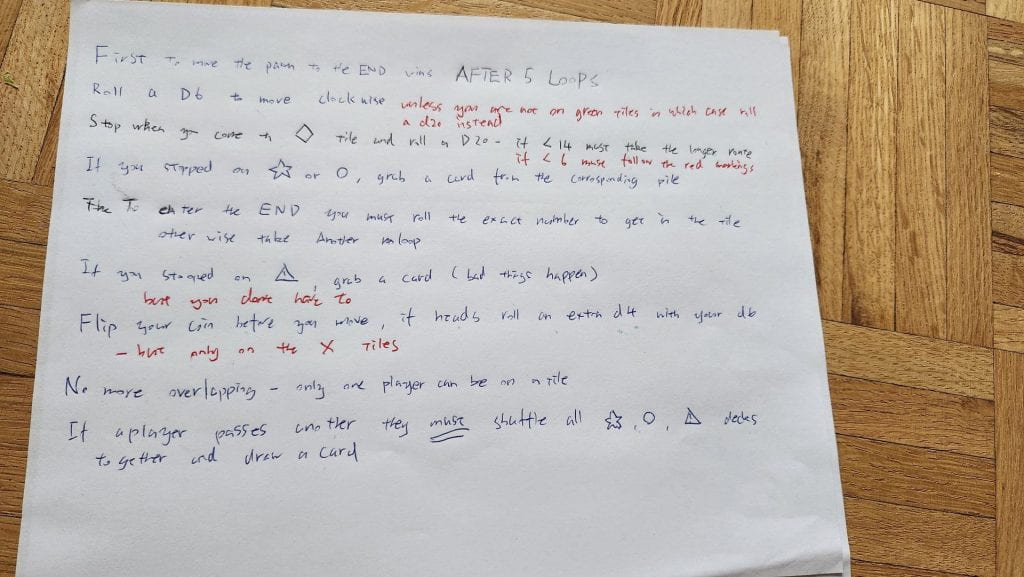
Recent Posts
Dada Collage: Hannover
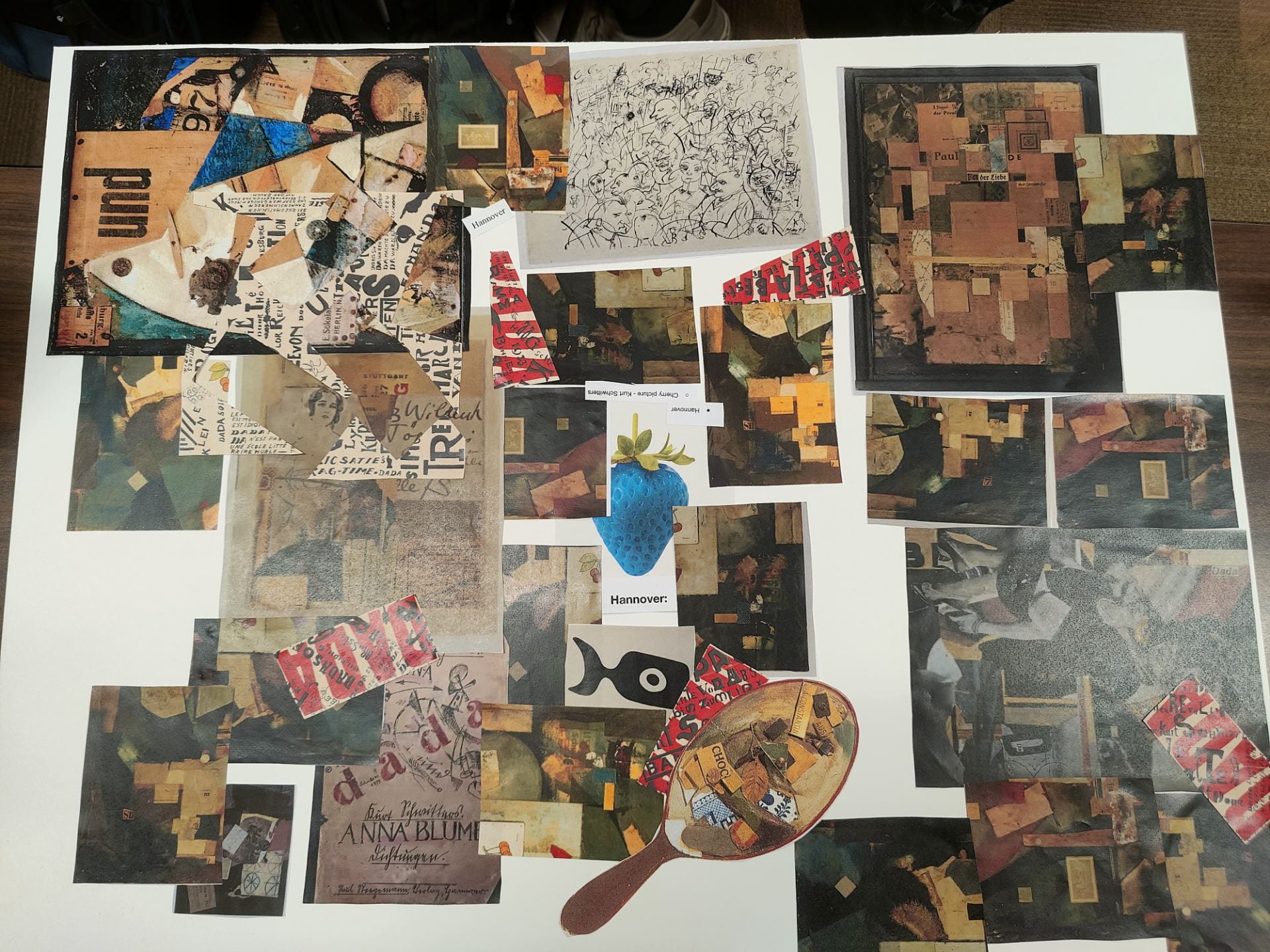
Dada Collage: Cologne

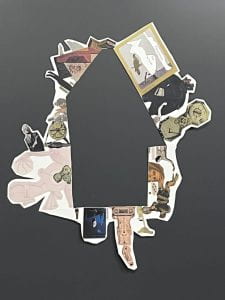
Berlin Dada Head Collage

Dada Collages Fall 2023
Each student was asked to bring one image from each of the six cities in Dada: Zurich, Berlin, Hannover, Cologne, New York, Paris by Leah Dickerman. Students then got into teams and created six collages, one representing the ethos of the dada community in each city. Here are the results!

Score: Making a game that isn’t fun
By Luca Sandoval
This is a game. It’s supposed to be fun. Here’s what you need to play it:
- A deck of face-down rule cards (provided.)
- A large handful of coins (not provided, obviously.)
The rules are very simple.
- There are two players. They each take turns flipping a coin, calling heads or tails before it lands.
- The person who guesses correctly gets a point.
- The first to one thousand points wins.
If at any point during the game you decide you aren’t having fun, feel free to draw the top card from the pile of rule cards. This should help make the game more fun.
————————————————————————————————-
(This section is not a part of the score.)
The rule cards provided are small pieces of paper that have the following messages, in order:
- New rule: Correctly calling the coin is now worth 10 points, but if you get it wrong, you lose a point instead.
- New rule: Each player can recruit another player as their additional team member. Those two players also flip a coin, and the points they either win or lose belong to the team.
- New rule: Each team should recruit three more players. At this point, it’s probably worth establishing some kind of team organizational structure. The original player is the ‘team captain,’ of course, but you should ask the new hires how they feel about that. They may choose to assist your cause, or not, I suppose.
- New rule: Add all of the coins you have left to the game. Coins are now valuable, maybe even more valuable than points (that isn’t currently clear). After all, at the end of the day, you have to put food on the table and keep the lights on, and points aren’t going to pay those bills. As a secondary requirement for victory besides reaching one thousand points, your team should also ensure they are financially better off than the other team by the end of the game.
- New rule: The team members have unionized. Team captains should have seen this coming. They all demand to be paid a fair wage in coins and won’t keep playing until those demands are met. As a new requirement for victory on top of the old ones, negotiate a fair contract with the team members.
- New rule: There’s been an economic recession. Everybody is hit hard, none more so than the innocent coin-flipping industry. Inflation has skyrocketed and coins and now next to worthless. You can sell back your team’s coins to the bank for fifty points each, which seems like an okay deal. However, as a consequence of the recession, the new requirement for winning is one hundred thousand points.
- New rule: There’s really no point in playing games anymore given the state of the economy.
Reflection:
My score was largely inspired by some of the works we saw relating to chess, and how artists in this movement would create twists on games that made them nearly impossible to play- and in the process allowed for the players to find their own fun using a broken ruleset. One that came to mind for my design was Yoko Ono’s White Chess Set, which featured an entirely white chessboard. This seems to make the game impossible to play, but in playing it I imagined that it might be its own sort of fun to attempt to remember which pieces were your own, or maybe just forgo the original rules altogether and simply play around with the broken ruleset. My score attempts to capture this energy by starting with a simple ruleset and slowly adding mechanics that derail it more and more until players are forced to find their own fun in the chaos. I also wanted the playing experience to be funny over anything else, thus the increasing absurdity of the rules.
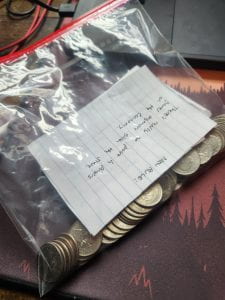
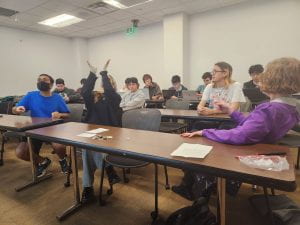
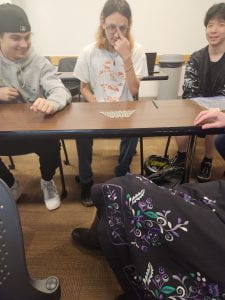

I was able to test my score two separate times, so it went through several revisions before the final. I was happy with the humor element of the score, as I feel in both cases the absurdity of the rules led to players creating comical situations, such as ‘firing’ their team leader or stealing/hoarding all the coins for their team. I do think that this score could be a bit more open-ended than the version I provided, and while I like the idea of the scenarios I’m providing for players (as a vehicle to create further comedy), it might be worth exploring a version of the game with less specific steps and punchlines while still maintaining the spirit of the score.
Score: Sketch and Stretch by T
Give each player 2 markers
Tell them to draw a picture
If they draw a circle, they do 5 jumping jacks
After 30 seconds, Vote
This score was designed with Yoko Ono’s work in mind, assigning seemingly random tasks to a straightforward idea. In this piece, the first goal of the game is simple – draw a random picture within a certain amount of time. However, much like a lot of Yoko Ono’s pieces in her book Grapefruit, there is a twist within the instructions that don’t seem to have any rhyme or reason for completing. This way of presenting a score is unique in the sense that it encourages outside-the-box thinking and exercises the creative part of one’s mind. However, where my score differs from any of the pieces in Grapefruit is that there is a more active engagement with the player, as opposed to having the reader ponder the meaning of the piece itself. In my score, this happens to be a disruption of the original idea through the use of physical exercise. This addition was inspired by the book about FLuxus, using the principle that the inclusion of multiple different people provides more room for creativity. By giving an open-ended task to the players to complete, it gives them all the power to create art in any way they want. Finally, the biggest inspiration for my Score would be the children’s games I used to play with my family, like pictionary or charades. These games have a simple premise with an emphasis on player engagement, and I wanted my score to reflect similar values. The game is designed to keep players on their toes, and force them to think about their approach to the game in a more abstract way, the same way a game of charades requires players to think creatively to win.
Score of a Cooking Game
Scores:
The players draw a dish card from the dish deck.
Carefully analyze the ingredients and picture of the dish on the Card
based on those materials, try to figure out the steps of making that dish
go through the “Score Guide”, one correct step for one point
the player with the most points wins!
https://docs.google.com/presentation/d/1CRKWg9k4eKjT3d3IgrubVLPblPhlXVvk/edit#slide=id.p1
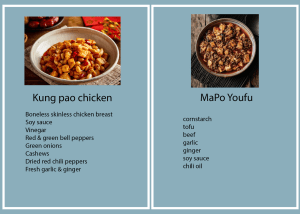
The reason why I made this game is because I thought it would be interesting to combine culinary recipes with board games. Theoretically, since everyone is on their own team, this game can be played with an infinite amount of people as long as you have enough cards for them. But because we only have two cards available, I would say at this moment, it is a game for 1 -2 people.
This game invites players to explore their culinary intuition by analyzing pictures of dishes and a list of ingredients. These elements serve as a canvas for players to envision the steps necessary to bring these dishes to life. As players must come up with their own recipes based on the materials, it’s just like painting on an empty canvas.
Score #1 – Board Game Constructor
Instructions:
- Designed to be played with at least 3 or 4 players
- The score is separated into two phases: construction and play
- During construction each player takes turn to add to the game – by drawing on the board, adding rules, pieces or other elements of the game
- During play each player takes turn to play the game
- Each construction phase lasts one round and play phase lasts two
- Existing rules cannot be overridden or removed, but can be appended
- The score begins with a blank piece of paper, during the construction phase
Materials recommended:
Pen, paper, RPG dice, cards and anything that can be used as pawns
The aftermath of a play session:
Author’s statement:
My personal inspirations for a game about making games traces back to my elementary school days: with us being obsessed with computer games but unable to play during the day, we spent launch breaks after lunch breaks turning our notebooks into interactive games with only pencils and imagination.
In relation to our class reading, I think my score is mostly inspired by the Fluxus’s focus of delivering the performance over the final product, and its collaborative but loose nature during the process of creation. Additionally, the score can also be seen as an exquisite corpse, since each participator contributes to the game in turn as the game progress forward.
While I originally intended for there to be a clear instruction about needing to have a winner or an end state of the game, I decided to remove the rule so the players can decide what happens at the end, or if there needs to be an end at all. I believe that sometimes, having the goal of a game to be perpetuating said game can be just as interesting as having an outcome. In addition, as the rule stated, players can only add to a game, not to remove them. as I view the game to be like a big canvas, where things cannot be erased even though newer additions would eventually overwrite older ones – even if they are no longer visible, they still make up the work. Finally, as the playtesting shows, there is an endless amount of possible product of this score, and I think this fits nicely to the themes of Fluxus and some of Yoko Ono’s scores, where the process of creation is constant, yet the same starting condition can turn into a chaotic amount of products.
Clash Chess: The Score
As shown in the link.
